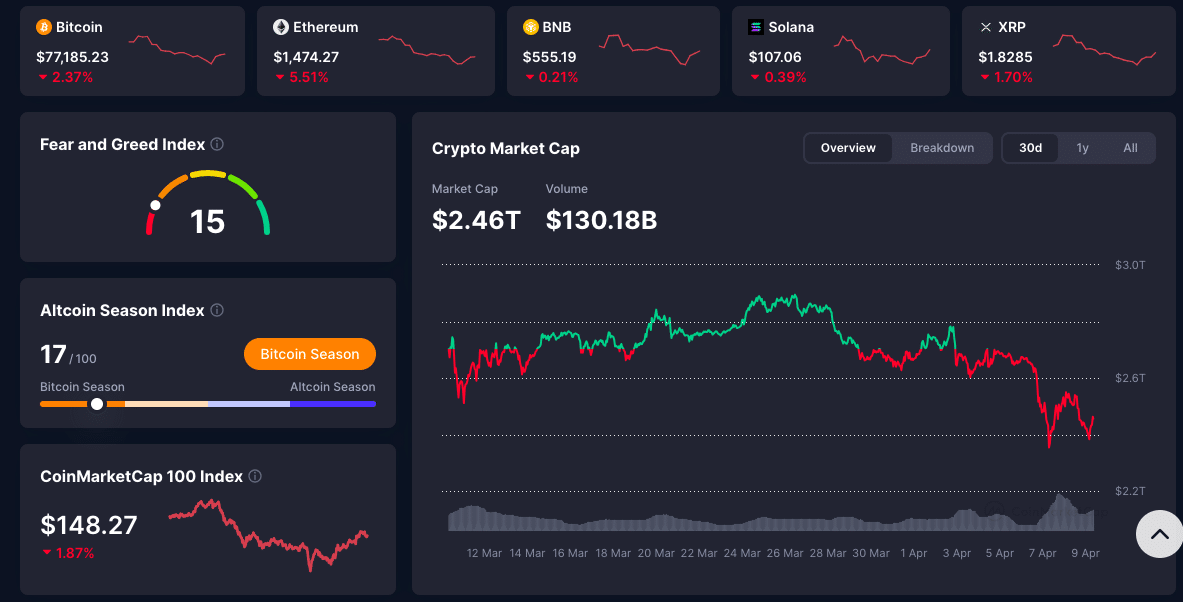The global financial system took a fresh beating on April 9 as U.S. President Donald Trump’s aggressive new tariffs, peaking at 104% for Chinese imports set off a chain reaction across Asian stock markets and the cryptocurrency sector. As investor confidence eroded, Bitcoin plunged below $75,000, over $400 million in leveraged crypto positions were liquidated, and major stock indices from Japan to Wall Street reeled under mounting pressure.
- Trump’s 104% Tariff Bombshell Sparks Global Market Chaos
- China Responds: “No Tolerance for U.S. Intimidation”
- Bitcoin Below $75K as Risk-Off Mode Takes Over
- Bitcoin ETF Exodus: Four Day Rally Ends with $224M Outflow
- Inflation Risk, Market Fragility, Household Strain
- Long-Term Outlook: Time to Accumulate?
- Conclusion: Policy Shockwaves Are Redefining Risk
- Glossary
The crypto sector, already under strain from macroeconomic instability and aggressive ETF outflows, now finds itself at the mercy of geopolitics. Trump’s trade war has reignited fears of a prolonged global downturn, drawing striking parallels to the 2008 financial crisis.
Trump’s 104% Tariff Bombshell Sparks Global Market Chaos
Just before markets opened in Asia, the Trump administration unveiled sweeping new tariffs targeting nearly every major trading partner. China was hit hardest, slapped with an unprecedented 104% import tax, more than four times higher than any previously imposed rate. Other key economies including India (26%), South Korea (25%), Japan (24%), and the European Union (20%) were also in the crosshairs.
Markets reacted immediately. Japan’s Nikkei 225 fell more than 3%, closing at 32,010.93, while the broader Topix lost 3% as well. In China, the CSI 300 dropped 1.2%, and Hong Kong’s Hang Seng Index plummeted 3.1%, driven by steep losses in tech and export-heavy sectors. These drops followed a brutal session on Wall Street, where the Dow Jones shed 320 points, closing at 37,645.59, and the S&P 500 fell 1.6%, now 19% off its February highs.
The tariffs came with little warning and no meaningful diplomatic lead-up. Trump, speaking aboard Air Force One, justified the move as “medicine” needed to correct decades of “stupid leadership” and restore U.S. economic power. But economists warn that this approach risks triggering stagflation where inflation rises even as growth stalls.

China Responds: “No Tolerance for U.S. Intimidation”
The Chinese government was quick to denounce the new tariffs. In a press briefing, the Foreign Ministry condemned the U.S. for its “unilateral intimidation tactics,” warning that China would “respond resolutely” if provoked further. The Ministry emphasized that fair trade cannot occur without mutual respect, calling the current U.S. approach a breach of international norms.
This combative tone sent a clear signal to markets: there will be no quick resolution. With no formal trade talks underway, analysts now expect China to retaliate with its own tariffs or restrictions on U.S. tech and agricultural imports. The escalating tit-for-tat dynamic has left global investors bracing for a prolonged economic standoff between the world’s two largest economies.
Bitcoin Below $75K as Risk-Off Mode Takes Over
As equities fell, the crypto market followed. Bitcoin dropped 6% in 24 hours to $75,359 wiping out billions in value, before retracing to about $77k at the time of this publication. Ethereum fell 10% to a daily low of $1,386 before recovering to $1,485.
The total crypto market cap fell 5.8% to $2.38 trillion according to CoinMarketCap. Over $404 million was liquidated from leveraged crypto trades—$304 million of which was from longs, showing a big change in sentiment. Bitcoin’s long-short ratio went bearish.
On-chain analytics platform Santiment noted that while prices fell, some metrics show long-term accumulation opportunities. Its MVRV (Market Value to Realized Value) divergence suggests altcoins are now in mid-term buy zones despite the broader market sell off.
Bitcoin ETF Exodus: Four Day Rally Ends with $224M Outflow
Adding to the sell off was a big reversal in Bitcoin spot ETF flows. After four days of inflows totalling $570M, April 8 saw a $224M outflow. Grayscale’s GBTC led the way with $303M in redemptions. While Bitwise’s BITB and BlackRock’s IBIT saw inflows of $40.3M and $21.3M respectively, it wasn’t enough to offset the overall exodus.
Fidelity’s FBTC saw a small $6.3M inflow but overall institutional sentiment is getting cautious. With US stock markets whipsawing due to tariff pressure, ETF investors may be cutting risk across the board.
This is a big shift in the institutional narrative for crypto, especially with political factors driving volatility in both traditional and decentralized markets.
Inflation Risk, Market Fragility, Household Strain
Wall Street is warning of an inflation surge due to the tariff escalation. The Fed hasn’t commented on the trade developments yet but the fear is that imported goods—from electronics to basic commodities—will get much more expensive soon.For households already under strain, this is bad news. As living costs rise and wage growth is stagnant, consumer confidence could drop, leading to reduced spending and a domestic demand shock. If inflation does rise, the Fed may have to raise rates again—making it even more hostile for risk assets like crypto.
Long-Term Outlook: Time to Accumulate?
Bitcoin has broken short-term support levels and is likely to go down to the $63,000-$67,000 range. This zone is both support and the average price at which large entities have accumulated. If Bitcoin breaks $70,000, sell pressure will accelerate and drag the rest of the altcoin market down with it. Ethereum, already behind Bitcoin in terms of dominance, will get hit even harder if BTC volatility continues.

Despite the chaos, some experts say this is a buying opportunity for long-term investors. Santiment’s on-chain data shows reduced profit-taking across mid-cap and small-cap altcoins, which is a sign of bottoming.
Short-term is still shaky, but the broader narrative of crypto as a hedge against political and financial instability is being tested again. If history is any guide, previous trade and monetary crises have led to big bounces in decentralized assets once the dust settles.
The road ahead will be rough, but seasoned crypto investors are watching for signs of stabilization and accumulation zones.
Conclusion: Policy Shockwaves Are Redefining Risk
What started as a routine policy update has become a pivot point for global markets. Trump’s 104% tariff blitz has thrown the world into economic chaos, and both the US and China are digging in. No resolution in sight and both sides are entrenched, traders are bracing for more volatility.
Crypto, once seen as a parallel financial universe immune to geopolitics, is proving to be deeply connected to global market dynamics. Whether this is a short-term disruption or the beginning of a bigger correction remains to be seen—but one thing is clear: the age of isolation is over and in today’s world, macro risks spare no asset class.
FAQs
Why is the crypto market down today?
Crypto market is reacting to global economic uncertainty caused by Trump’s 104% tariffs on Chinese imports. This has led to $400 million in crypto liquidations, mostly from longs.
What happened to Bitcoin and Ethereum prices?
Bitcoin dropped below $75,000 and Ethereum plunged 10% to a daily low of $1,386 before recovering slightly. Both were hit by risk-off sentiment in global markets.
How did the Bitcoin ETFs perform recently?
On April 8, Bitcoin spot ETFs saw a net outflow of $224 million, led by Grayscale’s $303 million in redemptions. This was the end of a 4-day inflow streak.
Will the tariffs lead to inflation in the US?
Economists say higher import costs will lead to inflation, especially for consumer goods. If inflation rises, the Fed may need to rethink rate hikes.
Is now a good time to invest in crypto?
While markets are down, some on-chain data shows accumulation opportunities in altcoins. Some Long-term investors may see this as a good time to get in gradually. However, it is advisable important to perform proper research before investing in any cryptocurreny.
Glossary
Tariff – A tax imposed by a government on imported goods to control trade and protect domestic industries.
Spot ETF – An exchange-traded fund that holds the actual underlying asset (e.g. Bitcoin) rather than derivatives or futures.
MVRV Ratio – Market Value to Realized Value; a metric to measure if an asset is overvalued or undervalued.
Liquidation – Forced closure of a leveraged trading position when the market moves against the trader’s prediction.
Long-Short Ratio – A measure of sentiment showing how many traders are betting the market will go up (long) versus down (short).



















































































































